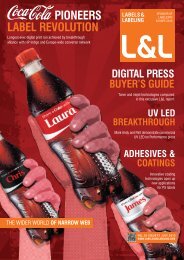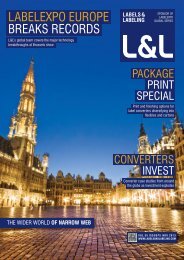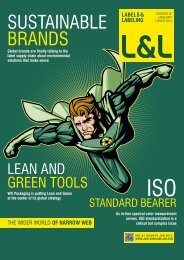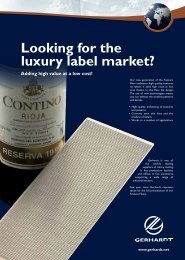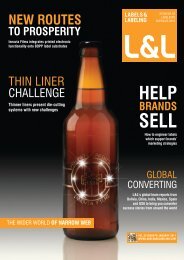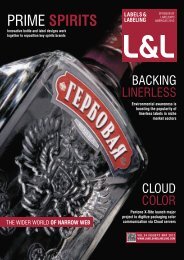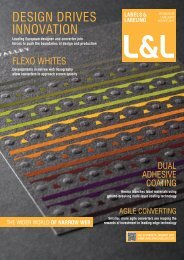THE DATA FRONT
Download as PDF - Labels & Labeling
Download as PDF - Labels & Labeling
- No tags were found...
Create successful ePaper yourself
Turn your PDF publications into a flip-book with our unique Google optimized e-Paper software.
46 | l&l<br />
A guide to anilox<br />
Lightweight anilox sleeves have many advantages over conventional rolls, but require a rigorous handling<br />
regime to avoid expensive damage. Tony Donato, Harper Corporation of America, explains<br />
The advent of anilox sleeves, with their<br />
lightweight construction and easy<br />
handling, has revolutionized setup and<br />
changeover times in the pressroom. As<br />
the technology continues to evolve and<br />
its benefits become more established,<br />
sleeves are appearing in more and more<br />
narrow web applications.<br />
Anilox sleeves are an investment,<br />
and proper care is critical to their<br />
performance and longevity.<br />
Anilox basics<br />
An anilox roller is the key component in<br />
a precision ink delivery system. Its most<br />
important feature is its engraving, which<br />
determines the number of cells on its<br />
surface and its volume, or the amount<br />
of ink it can transfer to the printing plate.<br />
The engraving is supported - kept round<br />
and straight - by the roller’s base. For an<br />
anilox to perform properly in the press,<br />
the circumference must be as round<br />
as possible, and the length must be as<br />
straight as possible under all operating<br />
conditions. The common term for the<br />
measurement of these characteristics is<br />
total indicator runout (TIR).<br />
Since the dawn of flexography, the<br />
conventional anilox roller’s base was a<br />
steel (rolling pin-looking) device. The<br />
conventional roller’s TIR is controlled<br />
by the thickness of its shell, and its own<br />
sleeve damage<br />
journals and bearings. Once a roller is<br />
loaded and the bearings locked in the<br />
blocks, it is ready to rotate.<br />
In contrast, the anilox sleeve is a hollow<br />
shell that has no bearings or journals<br />
of its own – it is completely dependent<br />
on the press mandrel for its rotation.<br />
Therefore, the condition of the mandrel,<br />
specifically its outer diameter (OD), has<br />
significant influence over a sleeve’s<br />
TIR. Before elaborating on the press<br />
mandrel, let’s review sleeves and their<br />
construction.<br />
Anatomy of an anilox sleeve<br />
An anilox sleeve possesses two key<br />
properties: First, the inside diameter<br />
(ID) or bore, is smaller than the outer<br />
diameter of the fixed mandrel. The bore<br />
expands when compressed air is blown<br />
in the press mandrel during mounting,<br />
and contracts to tightly grip the mandrel<br />
when the air is removed. This is called<br />
‘interference fit’.<br />
Second, the anilox sleeve must have<br />
the mechanical strength to accept the<br />
ceramic coating needed for engraving.<br />
The interference fit between the OD<br />
of the mandrel and the ID of the sleeve<br />
locks the sleeve in place for production.<br />
Because the interference fit dimensions<br />
can be as low as .0012” (30.5 microns),<br />
the cleanliness of both the mandrel and<br />
the inner liner of the sleeve are critical to<br />
the sleeve’s performance.<br />
Air-loaded anilox sleeves can range<br />
from 8mm to 15mm in total thickness and<br />
are comprised of the following layers: a<br />
fiberglass-reinforced inner liner that is<br />
made to match the mandrel, including<br />
interference fit. Next is the expansion<br />
foam layer, made of a material similar to<br />
foam mounting tape, mostly a closed-cell<br />
foam. The foam must be able to<br />
compress for mounting and expand back<br />
uniformly after the air is released. This<br />
rebounding of the foam is critical to the<br />
sleeve’s longevity: Once the foam does<br />
not rebound, the interference fit is lost<br />
and the TIR will go out of tolerance.<br />
The next layer is important because<br />
it supports the expansion foam. It<br />
varies in thickness, as it is adjusted to<br />
match the repeat needed. It is made<br />
of different materials depending on<br />
whether the sleeve is a composite sleeve<br />
or an aluminum-ribbed sleeve. In the<br />
composite sleeve, this layer is mostly<br />
fiberglass filler. In an aluminum-ribbed<br />
sleeve, this layer is comprised of the ribs<br />
themselves, which are approximately 5<br />
mm wide and vary slightly in height from<br />
5 to 7 mm.<br />
This layer is followed by the top layer<br />
of aluminum cladding, which can range<br />
from 3mm to 6mm in thickness. In a<br />
2mm worn off end of sleeve Deck leaking on mandrel below Dirty inner liner sticking issue<br />
Labels&Labeling



